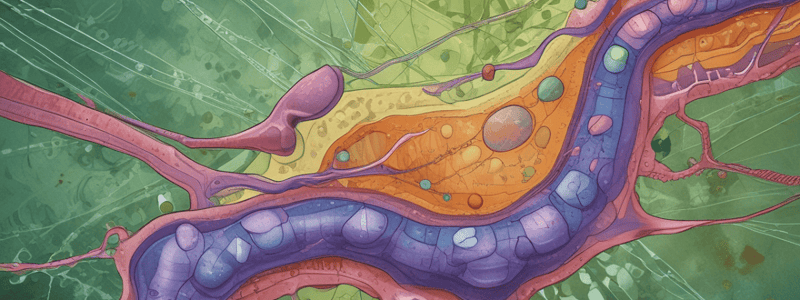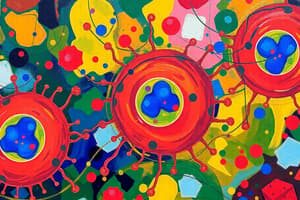Podcast
Questions and Answers
Which cell junction allows for the transport of ions, water, and other substances between neighboring cells?
Which cell junction allows for the transport of ions, water, and other substances between neighboring cells?
- Desmosomes
- Gap junctions (correct)
- Hemidesmosomes
- Adherens junctions
Which cell junction is particularly important in allowing the electrical signal to contract to spread rapidly between heart muscle cells?
Which cell junction is particularly important in allowing the electrical signal to contract to spread rapidly between heart muscle cells?
- Gap junctions (correct)
- Tight junctions
- Desmosomes
- Adherens junctions
Which type of cell junction creates a watertight seal between adjacent animal cells?
Which type of cell junction creates a watertight seal between adjacent animal cells?
- Desmosomes
- Tight junctions (correct)
- Adherens junctions
- Hemidesmosomes
What type of proteins create the gap junctions in vertebrates?
What type of proteins create the gap junctions in vertebrates?
Which cell junction plays a crucial role in regulating the structural integrity of tissues?
Which cell junction plays a crucial role in regulating the structural integrity of tissues?
Which cell junction is composed of claudins that hold cells tightly together?
Which cell junction is composed of claudins that hold cells tightly together?
Which cell junction forms an elongated, donut-like structure called a connexon?
Which cell junction forms an elongated, donut-like structure called a connexon?
What is the main function of tight junctions?
What is the main function of tight junctions?
Which junction is characterized by the interaction of cadherins in the space between cells?
Which junction is characterized by the interaction of cadherins in the space between cells?
What anchors hemidesmosomes within the cell?
What anchors hemidesmosomes within the cell?
Which of the following cell junctions form a branching network with a partner group on the opposite cell membrane?
Which of the following cell junctions form a branching network with a partner group on the opposite cell membrane?
How do desmosomes differ from tight junctions in terms of anchoring within the cell?
How do desmosomes differ from tight junctions in terms of anchoring within the cell?
Which cell junction is essential for maintaining tissue integrity and resisting mechanical challenges?
Which cell junction is essential for maintaining tissue integrity and resisting mechanical challenges?
'Spot welds' between adjacent epithelial cells are characteristic of which cell junction?
'Spot welds' between adjacent epithelial cells are characteristic of which cell junction?
'Joining intermediate filaments of neighboring cells together' is a feature of which cell junction?
'Joining intermediate filaments of neighboring cells together' is a feature of which cell junction?
During which stage of mitosis do chromosomes align at the metaphase plate?
During which stage of mitosis do chromosomes align at the metaphase plate?
How many rounds of cell division occur in meiosis?
How many rounds of cell division occur in meiosis?
What is the key difference between mitosis and meiosis?
What is the key difference between mitosis and meiosis?
In which stage of mitosis do sister chromatids separate and move to opposite ends of the cell?
In which stage of mitosis do sister chromatids separate and move to opposite ends of the cell?
What is the importance of mitosis in multicellular organisms?
What is the importance of mitosis in multicellular organisms?
Which stage of meiosis involves the separation of homologous chromosomes?
Which stage of meiosis involves the separation of homologous chromosomes?
What distinguishes meiosis from mitosis in terms of genetic material at the end of the process?
What distinguishes meiosis from mitosis in terms of genetic material at the end of the process?
Which process allows for genetic diversity in daughter cells?
Which process allows for genetic diversity in daughter cells?
What is the key difference between the number of daughter cells produced in mitosis and meiosis?
What is the key difference between the number of daughter cells produced in mitosis and meiosis?
In which phase do homologous chromosomes align at the metaphase plate?
In which phase do homologous chromosomes align at the metaphase plate?
What is the genetic content of the daughter cells produced in mitosis?
What is the genetic content of the daughter cells produced in mitosis?
Uncontrolled mitosis can lead to which of the following conditions?
Uncontrolled mitosis can lead to which of the following conditions?
Which process is crucial for growth and repair in multicellular organisms?
Which process is crucial for growth and repair in multicellular organisms?
Errors in meiosis can lead to which of the following conditions?
Errors in meiosis can lead to which of the following conditions?
Flashcards are hidden until you start studying
Study Notes
Cell Junctions: Gap Junctions, Tight Junctions, Adherens Junctions, Hemidesmosomes, and Desmosomes
Cell junctions are specialized cellular structures that play a crucial role in cell-to-cell communication and adhesion. They are composed of various transmembrane proteins and help maintain tissue homeostasis by regulating the structural integrity of tissues, the diffusion of ions, solutes, and microbes across the tissue, cell proliferation, and cell migration. Here, we will discuss the five main types of cell junctions: gap junctions, tight junctions, adherens junctions, hemidesmosomes, and desmosomes.
Gap Junctions
Gap junctions are channels between neighboring cells that allow for the transport of ions, water, and other substances. In vertebrates, they are formed by a set of six membrane proteins called connexins, which create an elongated, donut-like structure called a connexon. The pores, or "doughnut holes," of connexons in adjacent cells align, creating a channel between them. Gap junctions are particularly important in cardiac muscle, as the electrical signal to contract spreads rapidly between heart muscle cells through these channels, allowing the cells to contract in tandem.
Tight Junctions
Tight junctions create a watertight seal between two adjacent animal cells. At the site of a tight junction, cells are held tightly against each other by many individual groups of tight junction proteins called claudins. These proteins interact with a partner group on the opposite cell membrane, forming strands that form a branching network. The purpose of tight junctions is to prevent water and other substances from escaping between cells, allowing a layer of cells (such as those lining an organ) to act as an impermeable barrier.
Adherens Junctions
Adherens junctions join the actin filaments of neighboring cells together. They are characterized by a complex of proteins that extend across the membrane, including cadherins. These adhesion proteins interact in the space between the cells, holding the membranes together. Inside the cell, cadherins attach to a structure called the cytoplasmic plaque, which connects to intermediate filaments and helps anchor the junction.
Hemidesmosomes
Hemidesmosomes are weaker connections that connect intermediate filaments of a cell to the basal lamina, a combination of extracellular molecules on other cell surfaces. They play a role in the attachment of epithelial cells to the underlying basal lamina and are important for maintaining tissue integrity and resisting mechanical challenges.
Desmosomes
Desmosomes are even stronger connections that join the intermediate filaments of neighboring cells. They act like spot welds between adjacent epithelial cells. Like tight junctions, desmosomes involve a complex of proteins, including cadherins, which interact in the space between the cells. However, desmosomes are not characterized by a cytoplasmic plaque and instead rely on microtubules for their anchoring within the cell.
In summary, cell junctions are essential for maintaining tissue integrity, regulating the diffusion of substances between cells, and facilitating cell-to-cell communication. The different types of cell junctions, including gap junctions, tight junctions, adherens junctions, hemidesmosomes, and desmosomes, serve these functions in various ways and are crucial for the proper functioning of tissues in the body.
Studying That Suits You
Use AI to generate personalized quizzes and flashcards to suit your learning preferences.


